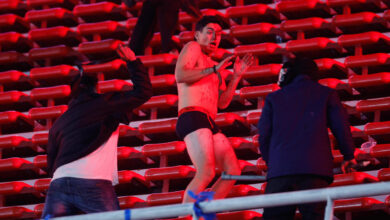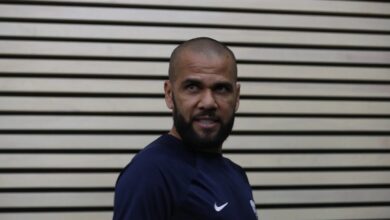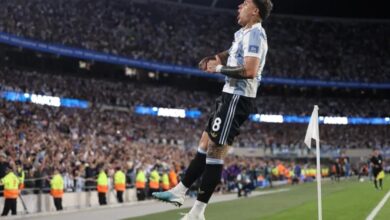Leadership Failures Fuel Persistent Soccer Violence Across Latin America

The 71-year-old head of Colombia’s soccer federation, Ramon Jesurún, and his son were arrested in Miami following an altercation with security guards after the Copa America final. The recent chaos at the Copa America final is a stark reminder that this issue will persist if those in leadership positions fail to set a positive example.
Soccer, the beautiful game, often turns ugly with violence both on and off the pitch. The recent chaos at the Copa America final is a stark reminder that this issue will persist if those in leadership positions fail to set a positive example.
The 71-year-old head of Colombia’s soccer federation, Ramon Jesurún, and his son were arrested in Miami following an altercation with security guards after the Copa America final. This incident, confirmed by Miami-Dade police on Monday, exemplifies the ongoing issue of violence in soccer and the critical role of leadership in addressing it.
Sunday’s final, which saw Argentina triumph over Colombia, was marred by delays and chaos. The match started over an hour late due to a police-initiated lockdown, leaving hundreds of fans outside Florida’s Hard Rock Stadium. Videos circulating on social media depicted security personnel clashing with fans attempting to breach the gates, setting the tone for a tumultuous evening.
Following the match, Jesurún and his 43-year-old son, Ramon Jamil, were involved in a violent altercation with security guards. According to Miami police reports, the confrontation occurred in a stadium tunnel where media gathered. Jesurún’s son allegedly grabbed a uniformed security guard by the neck, pulling him to the ground before punching and kicking him. Both Jesurún and his son were charged with battery.
Leadership in Disarray
The Colombian soccer federation’s silence after this incident speaks volumes. Over two dozen fans were arrested at the Copa America final, and more than 50 persons were ejected from the venue. Despite the presence of over 800 law enforcement officers, the event descended into chaos, highlighting the broader issue of violence that plagues soccer, especially in Latin America. This incident has not only tarnished the reputation of the federation but also raised serious questions about its ability to maintain order and discipline in the sport.
This incident is not isolated. It reflects a deeper problem within soccer’s leadership. When the very individuals who are supposed to uphold the integrity of the sport engage in violent behavior, it sends a dangerous message. It suggests that such conduct is acceptable, even at the game’s highest levels. This trickle-down effect perpetuates a culture of violence that affects players, fans, and the entire soccer community.
A Broader Latin American Context
Soccer violence is not just a Colombian problem; it is a pervasive issue throughout Latin America. The region has a rich soccer heritage, with passionate fans and historic rivalries. However, this passion often boils over into violence, both inside and outside stadiums. Incidents of hooliganism, clashes with police, and even fatalities are not uncommon. The problem is not confined to a single country but is a regional issue that requires a coordinated and comprehensive approach to address.
The Copa America, South America’s premier soccer tournament, has a history of over a century. Yet, the recurring violence associated with it tarnishes its legacy. The recent final in the United States, the second time the tournament has been hosted there, was meant to showcase the sport’s positive aspects. Instead, it highlighted the persistent issues of disorder and violence.
The Hard Rock Stadium’s statement on Monday underscored the challenges faced by event organizers. Despite increasing the number of law enforcement officers and security personnel to more than double that of a typical at-capacity event, they struggled to maintain order. The stadium’s gates were closed and reopened, but fans continued to engage in illegal activities, including fighting police officers, breaking down barriers, and vandalizing property.
The Need for Change
This situation illustrates the need for a comprehensive approach to addressing soccer violence. It requires robust security measures and a cultural shift within the sport. However, it also presents an opportunity for positive change. Leaders, from local clubs to national federations, can stand against violence and set a positive example. This includes implementing strict codes of conduct, enhancing fan education, and fostering a culture of respect and sportsmanship.
Soccer’s appeal lies in its ability to unite people, transcending borders and cultures. However, the violence associated with the sport threatens to undermine its positive impact. The incident involving Ramon Jesurún and his son at the Copa America final is a stark reminder that change must start at the top. Leaders who fail to exemplify the game’s values cannot expect fans and players to do so.
The fight against soccer violence is a collective responsibility. It requires commitment from everyone involved in the sport, especially those in positions of power. By addressing the root causes of violence and promoting a culture of respect, soccer can reclaim its status as a beautiful game and inspire future generations to enjoy it in a safe and positive environment. Together, we can make a difference.
Also read: Copa America 2024 Tactical Fouls Spark Controversy and Strategy Debate
Soccer violence will not stop if those in leadership positions continue to engage in and condone such behavior. The events at the Copa America final serve as a wake-up call. It is time for leaders to lead by example and take meaningful action to eradicate violence from the sport. Only then can soccer fulfill its potential as a unifying and uplifting force.





